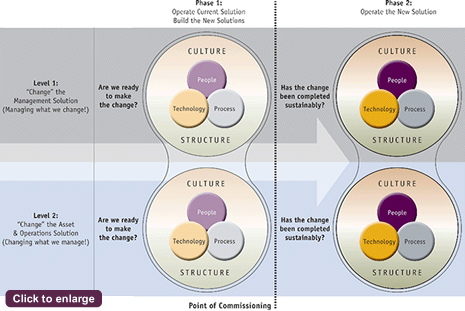Quadrants of change
Achieving change can be a big and complex undertaking. As specialists in change management, we have a deep understanding of the process and a keen sense for the defining characteristics of the ‘change game’. It is demanding, like any high-performance sport.
Since change is not an objective in itself, but rather a means of improving stakeholder value (through business enhancement and transformation), it is important to understand how the value is realised in context of where the change occurs.
The phases of change
Change involves the organisational structure and culture alike. It has two distinct phases and occurs on two distinct levels. These are termed the quadrants of change.
The process involves:
- Changes to the management situation i.e. Managing what we change
(Involves the business team);
- Changes to the asset and operations solution i.e. Changing what we manage
(Involves the project team).

Because the change is about a transformation from the status quo to the desired solution, it involves two phases i.e. two halves - before and after commissioning
- The current solution (concerned with ensuring readiness for building the new solution)
- The new solution (concerned with commissioning and consolidating the new solution)
Of course, the point of the exercise is to derive the desired value. This only comes to fruition in the final phase of the process, thus demonstrating that all elements are crucial parts of the equation.

BET = Business enhancement and transformation
PPT = People, process and technology
Who is in charge of change?
Organisations have a number of senior executives with overall functional responsibilities. Roles include Chief Information Officer, Chief Financial Officer, Chief Operating Officer etc.
However, the area of change is not typically assigned to a senior executive role and often rests with the CEO by default.
Caravel’s approach addresses this shortcoming. We promote the establishment of a Chief Change Officer, or Chief of Business Enhancement and Transformation. This reflects the need for a high level corporate officer with responsibility for business enhancement and transformation.
Addressing key change attributes
At Caravel® we know that change is all about applying a co-ordinated mix of
(1) workforce capability, (2) technology & systems, and 3) process – as the diagram below suggests.
However, managing this ‘mix’ as a composite whole, clearly demands multifaceted experience and resources.
Caravel’s large multi-disciplinary team (augmented with specialists for some niche activities) is a core component of our ability to deliver an end-to-end change management service. This ensures that we cover the full change cycle.

Caravel® has the necessary expertise to drive change in all respects. To provide an end-to-end service, we work with our pool of specialist providers in the area of Culture & Attitudes.
|